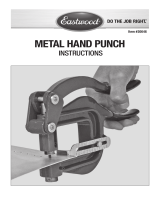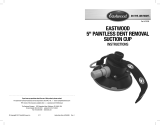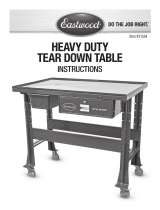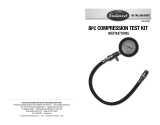Page is loading ...

PLANISHING HAMMER
INS TRUCTIONS
Item #21270

2 Eastwood Technical Assistance: 800.544.5118 >> techelp@eastwood.com
The PLANISHING HAMMER has long been used in metal fabrication and restoration to smooth large areas of metal, welds and gentle panel crowning.
The sturdy frame with a generous 19.63” throat depth, is beefy enough to smooth 18-gauge steel! A quick release allows the lower shaft to slide down
to accept panels with deep flanges and facilitate fast Anvil changes. The power head adjustment controls the intensity from light to very powerful hammering.
A convenient foot control starts and stops the hammer.
CONTENTS
(1) Rear Leg - [A]
(1) Brace - [B]
(1) Foot - [C]
(1) Front Leg - [D]
(1) Frame Assembly - [E]
(1) Hammer / Pedal Assembly - [F]
(1) 5mm Hex Key - [G]
(1) Retaining Spring - [H]
(1) Striking Head - [J]
(3) Anvils,
1” Radius, 2” Radius & 3” Radius - [K]
(3) Threaded Plugs - [L]
(2) M8 x 75mm Bolts - [M]
(2) M8 x 50mm Bolts - [N]
(2) M8 x 20mm Bolts - [P]
(4) M8 Lockwashers - [Q]
(4) M8 Nuts - [R]
(4) M10 x 30mm Bolts - [S]
(8) M10 Washers - [T]
(4) M10 Nuts - [U]
TOOLS REQUIRED
• (2) 14mm Wrenches
SPECIFICATIONS
Speed: 825 - 1350 Beats per Minute
Operating Pressure: 50 - 90 PSI
Throat Depth: 19.63”
Anvil Crowns: 1”R, 2”R, 3”R
Cam Height Adjustments: 4 Steps
A
B
C
D
E
F
G
H
J
K
L
M
N
P
Q
R
S
T
U

DANGER indicates a hazardous situation which, if not avoided, will result in death or serious injury.
WARNING indicates a hazardous situation which, if not avoided, could result in death or serious injury.
CAUTION used with the safety alert symbol, indicates a hazardous situation which, if not avoided, could result in minor or moderate injury.
NOTICE is used to address practices not related to personal injury.
READ INSTRUCTIONS
• Thoroughly read and understand this manual before using.
• Save for future reference.
PINCH AND CRUSH HAZARD!
• Keep fingers and hands away from moving parts when operating.
CUT HAZARD!
• Handling sharp metal can cause serious cuts. Wear thick, well fitting work gloves to prevent cuts from handling sharp metal.
BURST HAZARD!
• Excessive air pressure can cause tool to explode resulting in tool damage and personal injury. Do not exceed 90 psi [6.3 bar]
of tool inlet air pressure.
INJURY HAZARD!
• This tool can quickly start up while connected to an air supply causing serious personal injury. Always disconnect the
Planishing Hammer from the air supply before changing Anvils or performing maintenance.
EYE INJURY HAZARD!
• Rapidly moving surfaces can eject metal particles, dirt and oils at high velocity. Always wear ANSI approved eye protection
when operating this tool.
HEARING DAMAGE HAZARD!
• The Eastwood Pneumatic Planishing Hammer emits extremely loud sounds while operating. Use ANSI approved ear protection
when operating this tool.
INJURY HAZARD!
• The Eastwood Pneumatic Planishing Hammer consists of heavy metal components which can present a hand/finger pinch hazard and
cause potentially serious injuries if dropped. Avoid pinching hands while handling parts during assembly. The use of safety shoes is
strongly recommended.
VIBRATION INJURY HAZARD!
• This tool will vibrate during use! Repeated exposure to vibration may cause physical injury.
• The Eastwood Planishing Hammer was specifically designed to be operated by one person only. Never have one person operate
the Foot Pedal while another handles the workpiece or serious injury could occur.
SAFETY INFORMATION
The following explanations are displayed in this manual, on the labeling, and on all other information provided with this product:
To order parts and supplies: 800.345.1178 >> eastwood.com 3

4 Eastwood Technical Assistance: 800.544.5118 >> techelp@eastwood.com
ASSEMBLY
• Lay the Rear Leg (A) on a soft, clean surface and slip
an M8 x 75mm bolt (M) through the hole at the lower
end and thread it into the angled end of the Brace (B)
(FIG 1).
• Stand the Rear Leg and Brace (A&B) up and slip the
2nd M8 x 75mm bolt (M) through the hole at the
center of the Foot (C) and thread it into the straight
end of the Brace (B) (FIG 1).
• Set the small plate of the Front Leg (D) with the two
holes over those of the Foot (C), place two M8 x
50mm Bolts (N) down through the Foot and Front
Leg and add two M8 lockwashers (Q) and M8 nuts
(R) (FIG 2).
• Attach the Top Plate of the Front Leg
(D)
to the
Rear Leg
(A)
flange with two M8 x 20mm Bolts
(P)
, M8 Lockwashers
(Q)
and M8 Nuts
(R) (FIG 2)
.
The Eastwood Pneumatic Planishing Hammer
consists of heavy metal components which
can present a hand/finger pinch hazard and
cause potentially serious injuries if dropped.
Avoid pinching hands while handling parts
during assembly. The use of safety shoes is
strongly recommended.
✓
FIG. 1
A
B
C
M
✓
✓
✓
M
✓
FIG. 2
E
E1
E2
E3
E4
S, T, U
A
D
B
M
N, Q, R
M
C
✓
✓
✓
✓
✓
✓
✓
✓
✓
✓
✓
✓
✓
✓
• Carefully set the Frame (E) on top of the assembled
Stand with the open, working end located over the
Foot then place four M10 x 30mm Bolts (S) down
through the Frame and Front Leg and add two M10
washers (T) and M10 nuts (U) (FIG 2).
✓
P, Q, R

To order parts and supplies: 800.345.1178 >> eastwood.com 5
• Place the Hammer/Pedal Assembly (F) into the opening of
the upper Frame with the Hose trailing toward the back
and lock securely into place with the Hex Key (K) (FIG 3).
• Remove the Support Pin (E4, PRE INSTALLED) by pulling
it from the Lower Frame (E) and Anvil Support (E1, PRE
INSTALLED) then set it aside. Carefully lower the Anvil
Support until it rests on the snap ring (FIG 3).
• With the smaller loop facing upward, thread the Spring (H)
onto the nose of the Hammer (FIG 4).
• Pull the lower loop of the Spring (H) out and down while
inserting the shaft of the Striking Head (J) up into the
plunger of the Hammer. Be sure the lower loop of the
Spring is located between the back of the Striking
Head Face and the raised rib after installing (FIG 4).
FIG. 3
FIG. 4
✓
✓
✓
✓
E1
E2
E3
E4
✓
✓
✓
✓
✓
E
K
F1
F2
F3
✓
✓
✓
✓
✓
F1
E
H
J
J1

6 Eastwood Technical Assistance: 800.544.5118 >> techelp@eastwood.com
• With the Anvil Support (E1, PRE INSTALLED) still in the down
position, insert one of the three Anvils (K) into the bore in the
top (FIG 5).
• Pull the Anvil Support (E1, PRE INSTALLED) up and replace the
Retaining Pin (E2, PRE INSTALLED) by pushing it through the tab
of the Frame and through hole of the Anvil Support (FIG 6).
• The Planishing Hammer makes a great deal of noise and vibration
while running. It is strongly advisable to securely bolt the frame to a
floor and fill the frame with steel shot, sand or similar dense sound
absorbing material. There are three locations to add material to the
Frame and Stand. The upper rear of the Frame (E), the Rear Leg (A)
and the Front Leg (D).
• To fill; tilt the Frame and Stand Members as necessary to allow the
Threaded Bungs to face upward then use a funnel to pour material
into the Frame. Be sure to clear threads and securely install the
three Plugs (L) when done (FIG 7).
REQUIRED FOR USE
• The inlet air supply must have a moisture separator capable of
removing all moisture and impurities from the air supply. Moisture
and/or oil in the air supply will cause corrosion and failure of the
Air Hammer.
• A suitable regulator must be used to limit incoming air pressure to
90 PSI maximum. Excessive air pressure can cause permanent dam-
age to the unit and possible serious personal injury from bursting.
• For best results, a compressor capable of providing a minimum of 4
CFM @ 90 PSI is required. Less available CFM will not provide suf-
ficient force to allow the Planishing Hammer to adequately function.
• For best performance, a minimum of 3/8” air line is strongly
recommended.
SET-UP
• Connect the 1/4” Quick Disconnect of the Foot Pedal (F4) to the
air inlet supply.
• Rotate the Cam (E2) by moving the lever forward or back. There are
four steps which raise or lower the Anvil Support (E1), as required
to accept the various thickness and hardness of sheet metal being
worked (FIG 8).
• Generally thicker gauge metal will require a lower setting while
thinner gauge will harder metal (steel) will require a higher setting.
Conversely, a softer metal (aluminum and copper) will respond better
with a lower Cam setting while steel may be best at a higher setting.
• Choose one of the three crowned Anvils based on which profile best
suit your needs. The 3” Radius will produce the gentlest radius while
the 1” will make the tightest.
NOTE: The final radius will always be greater than that of the Anvil in
use and the amount of working the metal will dramatically affect the
finished radius as well.
FIG. 5
FIG. 6
FIG. 7
FIG. 8
✓
F
✓
✓
✓
✓
✓
✓
✓
E
H
J
K
E1
E4
E3
✓
✓
✓
✓
✓
✓
E1
E2
E3
E
Rotate
E4
E2
L
✓
Rotate
Up
Down

To order parts and supplies: 800.345.1178 >> eastwood.com 7
OPERATION
• The speed of the Hammer may be set by rotating the knob on the Throttling Valve
(F2). Adjusting by turning “MAX” to align with the body of the Valve increases
speed while turning “O” to align will decrease speed (FIG 9).
• Place the metal between the Striking Head and Anvil and adjust the Cam height
as needed.
• Grip panel firmly and step on the Foot Pedal (F4) to run the Planishing Hammer.
• Move the workpiece panel around as necessary to form a crown or smooth out
previously hammered, pleated, shrunken or stretched panel.
• A helpful tip is to create a gauge out of firm cardboard or wood before forming a
crowned panel so that you may check your progress against it as you go.
MAINTENANCE
• Add several (3-5) drops of air tool oil to air inlet before each use.
• If tool is to be unused for an extended period, add 10 drops of air tool oil to the
inlet before storing.
• Keep Striking Head and Anvil surfaces clean of grit, metal chips, excess oil
and debris.
PINCH AND CRUSH HAZARD!
Keep fingers and hands away from moving parts when operating.
CUT HAZARD!
Handling sharp metal can cause serious cuts. Wear thick,
well-fitting work gloves to prevent cuts from handling sharp metal.
HEARING DAMAGE HAZARD!
The Eastwood Pneumatic Planishing Hammer emits extremely
loud sounds while operating. Wear adequate hearing protection
while using.
The Eastwood Pneumatic Planishing Hammer was specifically
designed to be operated by one person only. Never have one
person operate the Foot Pedal while one handles the material
workpiece or serious injury could occur.
Never run the Planishing Hammer without a piece of metal between
the Striking Head and Anvil or permanent damage to the hardened
steel components can occur.
The Planishing Hammer as with many advanced metal working
craft tools, requires a learning curve to become proficient in its
use. Plan on using a generous amount of practice material in order
to achieve a “feel” for the tool and learn what results to expect
before attempting a finished piece.
FIG. 9
FIG. 10
FIG. 11
✓
F1
✓
✓
F2
F3
Fast
Slow

© Copyright 2016 Easthill Group, Inc. 8/16 Instruction Item #21270Q Rev. 0
If you have any questions about the use of this product, please contact
The Eastwood Technical Assistance Service Department: 800.544.5118 >> email: techelp@eastwood.com
PDF version of this manual is available online >> eastwood.com/21270manual
The Eastwood Company 263 Shoemaker Road, Pottstown, PA 19464, USA
US and Canada: 800.345.1178 Outside US: 610.718.8335
Fax: 610.323.6268 eastwood.com
PROBLEM CAUSE CORRECTION
Poor Hammer
Performance
Throttling Valve not sufficiently open Turn Throttling Valve toward “MAX”.
Compressor inadequate, insufficient
CFM
For best results, a compressor capable of sustaining at least 4 CFM @ 90 PSI is
recommended. Lesser output will result in diminished performance.
Pinched, kinked or damaged air supply
hose
Straighten or replace air supply if required. Note: The shorter the air supply
hose is, the better the performance.
Air Hammer requires maintenance
Disconnect air supply to Foot Pedal. Remove air supply hose and Throttling
Valve at inlet of Air Hammer and add 10 drops of a good quality air tool oil.
Moisture in air line Eliminate source of moisture/water in air supply.
Excessive or
Unusual Noise
and Vibration
Loose Fasteners Check and tighten all Stand, Frame and Hammer mounting hardware.
TROUBLESHOOTING
/










